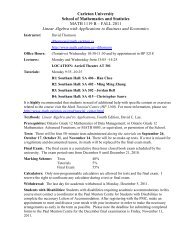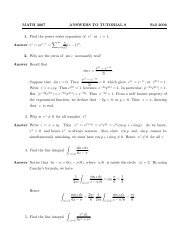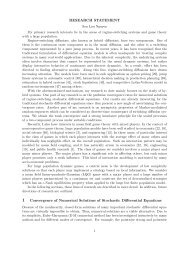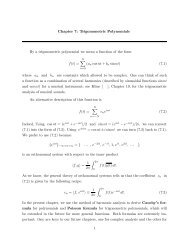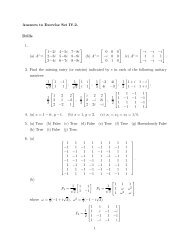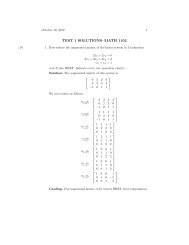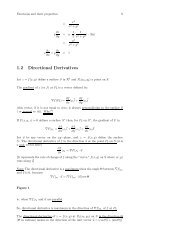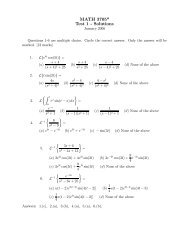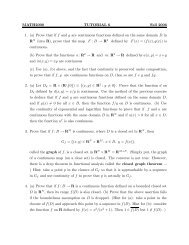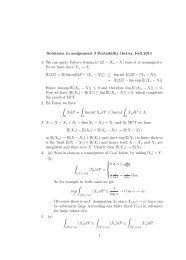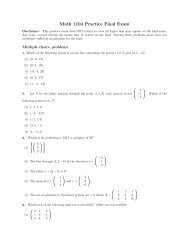CHAPTER II DIMENSION In the present chapter we investigate ...
CHAPTER II DIMENSION In the present chapter we investigate ...
CHAPTER II DIMENSION In the present chapter we investigate ...
You also want an ePaper? Increase the reach of your titles
YUMPU automatically turns print PDFs into web optimized ePapers that Google loves.
EXERCISE SET <strong>II</strong>. 2.<br />
Review Questions. Can I give all technical aspects in defining <strong>the</strong> dimension of a vector<br />
space? Can I make each of <strong>the</strong> following vague statements precise and prove it?<br />
“Spanning sets have more (at worse equal number of) vectors than independent set.”<br />
“A spanning set can be trimmed down to a basis.”<br />
“An independent set can be extended to a basis.”<br />
“An independent set is a basis of its span.”<br />
Can I explain <strong>the</strong> identity “rank + nullity = dimension” in detail? Do I know how to<br />
prove this identity?<br />
Drills<br />
1. Give <strong>the</strong> dimension of each of <strong>the</strong> following vector spaces over R.<br />
(a) R 4 , (b) P5, (c) M3,4, (d) FX with X = {1, 2, 3, 4}.<br />
2. What is <strong>the</strong> dimension of C when it is considered as a vector space over R? What<br />
about C n , also considered as a vector space over R?<br />
3. True or False:<br />
(a) A linear homogeneous system of 100 equations with 99 unknowns (or variables)<br />
must have a nontrivial solution.<br />
(b) A linear homogeneous system of 100 equations with 200 unknowns must have a<br />
nontrivial solution.<br />
(c) 100 vectors in a subspace spanned by 50 vectors must be linearly dependent.<br />
(d) If a subspace M is spanned by 50 linearly independent vectors, <strong>the</strong>n <strong>the</strong> dimension<br />
of M is at most 50.<br />
(e) If vectors v0, v1, v2, . . . , v50 are linearly independent, <strong>the</strong>n <strong>the</strong> dimension of <strong>the</strong><br />
subspace M spanned by <strong>the</strong>m is 50.<br />
(f) If v1, v2 and v3 span a 2-dimensional vector space V , <strong>the</strong>n one of <strong>the</strong> following<br />
three sets is a basis of V : S1 = {v2, v3}, S2 = {v1, v3}, S3 = {v1, v2}.<br />
(g) If v1, v2, v3, . . . , v99 are linearly independent vectors in a vector space V with<br />
dim V = 100, <strong>the</strong>n <strong>we</strong> can pick a vector v100 in V such that v1, v2, . . . , v99, v100<br />
form a basis of V .<br />
24



